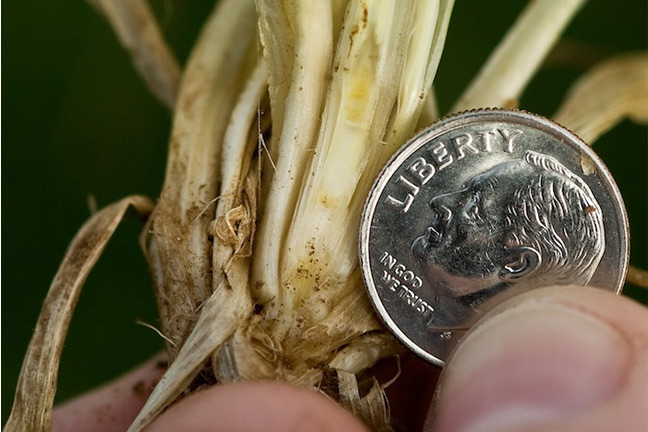
Agricultural News
Producers with a Dual-Purpose Wheat Crop Should Start Checking for First Hollow Stem Stage
Mon, 20 Feb 2017 14:00:40 CST
 Oklahoma producers who plant winter wheat as part of a dual-purpose graze-and-grain management system need to ensure cattle are not grazing past first hollow stem stage of the crop.
Oklahoma producers who plant winter wheat as part of a dual-purpose graze-and-grain management system need to ensure cattle are not grazing past first hollow stem stage of the crop.
David Marburger, Oklahoma State University Cooperative Extension small grains specialist, explains grazing prior to first hollow stem, often referred to as FHS, typically has a limited effect on wheat yields but extended grazing beyond that stage can greatly reduce yields.
"Yield loss from grazing past first hollow stem can be as much as 1 percent to 5 percent per day," he said. "It comes down to the amount of green leaf tissue left and the weather conditions after grazing. Cool, moist conditions after cattle removal allow for more time for the plants to recover."
FHS occurs when wheat stems begin to elongate and the stem above the roots and below the developing head becomes hollow. Typically, this occurs when the hollow stem portion of the plant is 5/8 inch long.
"The occurrence of first hollow stem depends on the wheat variety and on climatic factors such as temperature and precipitation," Marburger said.
To check for FHS, go to a non-grazed area of the pasture and pull four to five plants. Plants must be dug up because much of the hollow stem present will be below the soil surface.
"Hollow stem must be measured from a non-grazed area in the same wheat field because the act of grazing delays stem elongation and therefore when first hollow stem occurs," Marburger said.
Good places to find suitable plants are the corners of a pasture or non-grazed areas just outside the fence line. Select the largest tillers on the plants. Split the stems open lengthwise starting at the base.
"A sharp razor or box cutter will make the job easier," Marburger said. "If there is 5/8 inch of hollow stem below the developing wheat head, it's time to pull cattle off the wheat pasture. If you don't have a ruler, a dime is a good measuring device for first hollow stem as the coin is about 5/8 inch diameter."
Naturally, early-sown wheat will tend to reach FHS before late-sown wheat. Moderate wintertime conditions such as what Oklahoma has experience in the past few months and adequate rainfall also will promote earlier onset of FHS.
A smartphone app, the Mesonet First Hollow Stem Advisor, may prove useful to producers. The app uses 4-inch Soil Temp Under Vegetative Cover to estimate probabilities for the date when FHS is expected to occur.
Available on the Mesonet website - the FHS Advisor is located in the Agriculture section, under both the "Crop/Wheat" and "Livestock/Cattle" tabs. A guide on how to use the Advisor is located in the "Learn More" section of the website.
"Producers can select their wheat variety and then use maps, charts or graphs to check probability of first hollow stem occurrence," Marburger said. "This online tool is a great way to better know when it is time to start scouting instead of using a specific calendar date or just going by the weather. The most accurate method of determining first hollow stem stage is still checking your wheat fields often."
For most expected weather and price conditions, extending grazing beyond FHS for wheat intended for grain harvest is not likely to generate more net income than terminating grazing at FHS.
Additional information about dual-purpose graze-and-grain wheat systems is available online. Recommended OSU fact sheets include PSS-2147, "First Hollow Stem: A Critical Wheat Growth Stage for Dual-Purpose Producers," and AGEC-265, "The Effect of Grazing Past First Hollow Stem on Wheat and Stocker Profits."
Source - Oklahoma State University
WebReadyTM Powered by WireReady® NSI
Top Agricultural News
More Headlines...





